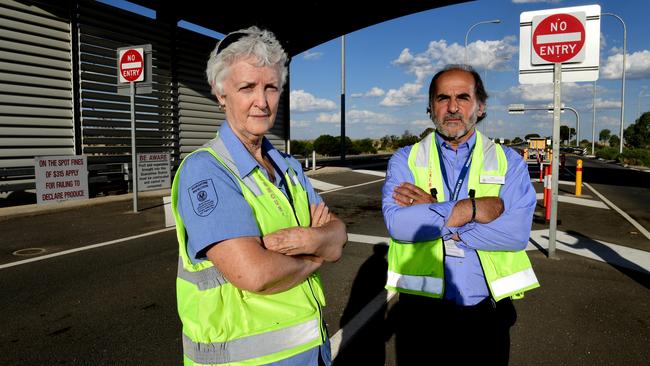The ever-growing fruit fly threat to the Riverland has its multimillion-dollar horticulture industry on edge
THE Riverland’s horticulture industry is under siege from the growing threat of a fruit fly outbreak sweeping the east coast. Rural Editor BELINDA WILLIS reports on the need for greater vigilance.

SA Business
Don't miss out on the headlines from SA Business. Followed categories will be added to My News.
- How SA’s largest fruit fly outbreak in decade went undiscovered
- Biosecurity SA declares outbreak of Queensland fruit fly in Hillcrest
- Keeping SA fruit fly free needs coordinated approach: Greg Barila
A SINGLE quarantine outpost is the only barrier between a debilitating fruit fly outbreak in Victoria’s Sunraysia region and the Riverland’s multimillion-dollar fruit and vegetable industry.
As the pest spreads across Victoria, the Yamba quarantine station, on Sturt Hwy between Mildura and Renmark, has already confiscated nine lots of infested fruit and vegetable coming from the Sunraysia district this year.
Station assistant supervisor Craig Solly claimed Victoria had dropped the ball and the Sunraysia region was “getting more and more fruit fly” after losing its pest-free status in 2014.
“The troops are getting closer, it becomes a bit more desperate as that gets closer and closer and closer – we have to be more vigilant,” he said.
Further threats are coming from the city of Adelaide, with the state forced to spend $1.5 million last year fighting off the state’s largest fruit fly outbreak in a decade in the Clarence Park area.
Biosecurity SA’s state compliance chief Mark Langham said the threat to the state’s $1.1 billion horticultural industry was further fuelled by a spike in “grey nomads” traversing the country in caravans loaded with produce from infested towns and cities interstate.

“And it takes three times longer for us to search a caravan as it does to check a car,” he said.
And he said that despite extensive signage, handouts, advertisements and roadside bins lining roads leading into the state’s fruit regions, many people stopped at random road blocks claimed they had not seen a single sign.
The department has about 16 staff working around the clock at the Yamba station despite threats from the State Government in 2010 to cut its 24-hour operations to 12 hours.
It estimates a Riverland outbreak could cost $2 million to contain and it also risked losing lucrative export markets relying on its unique fruit fly-free status.
Ellen Kennedy has worked at the Yamba station for 23 years and is acutely aware of the dangers, saying she had family members working in the Riverland fruit industry.
“The minute we have a fruit fly outbreak, the export market is closed down,” she said.
The state is under attack on two fronts — from Mediterranean fruit fly in the west and the threat of Queensland fruit fly sweeping down the east coast of Australia.
Bookpurnong stone fruit grower Jason Size said while Sunraysia was “the biggest worry” with its threat of spreading Queensland fruit fly, cars, trucks and buses travelling through Bordertown, Pinnaroo and even Riverland residents returning from trips to Adelaide were a hazard.
“I don’t know if the message has got out there,” said Mr Size, who is also a member of the Riverland Fruit Fly Committee and SA standing committee on fruit fly.
“Especially when there’s been Mediterranean fruit fly outbreaks in Adelaide.”
It took 150 casual staff and 10 biosecurity supervisors from February until Christmas last year to eradicate the Mediterranean fruit fly outbreak in Adelaide, including releasing one to two million sterile male fruit flies a week.
“If we have fruit fly, it would cost growers millions for chemical control or cold treatments,” Mr Size said.
Despite the state spending $5 million fighting fruit fly in 2015-16, there were still 81 fruit fly detections spread across its four static roadblocks, random checks and more than 3500 trap sites.
Agriculture Minister Leon Bignell launched a National Sterile Insect Technology facility in Port Augusta last year to produce 50 million sterile male Queensland fruit flies each week to help kill off the pests.
The Victorian Government contributed $900,000 and South Australia $3.84 million. Mr Bignell did not reply to numerous questions about how South Australia is being protected against the pest.



